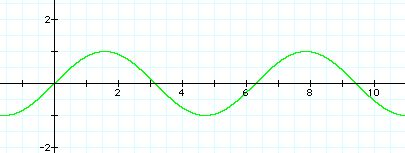
Examining the Sine
Function
By
Audrey V. Simmons
We will be examining the sine function as the coefficient
values change to see what effect the change has on the graph.
Examine graphs of y = a sin(bx + c) for
different values of a, b, and c.
Our first step will be to:
Look at the basic
sine graph when a=1, b=1 and c=0
y = sin(x).
Notice that the Domain is the set of real numbers, and the Range is [-1,1]. The Period for the sine function is ![]() . The graph of the sine
function continues indefinitely.
. The graph of the sine
function continues indefinitely.
The period is the time it takes for the graph to
make one complete cycle
or in other words, the amount of time it takes for the graph to begin
repeating. In this case ![]() .
.
The amplitude is the distance from the axis to the
highest or lowest point. Or it is half the distance from the highest to the
lowest point. In this case the amplitude is 1.
Using the basic sine graph as our
frame of reference. Let's look at what happens to the graph under the following
guidelines.
Step 1: a sin (bx +c)
Let b=1,c=0, and vary the values of a. Our
new equation becomes y=a sin(x).
Use the graphing calculator to try different
values for a. Remember to try positive and negative values.
y = 2 sin x, y = 5 sin x, and y = -3 sin x
The green graph
is y=sin x. The basic sine graph will always be in green in future examples for
comparison purposes.

When the values of a are positive, the
amplitude is increased by a factor of the absolute value of a, and the graph
follows the basic sine graph shown above. This is known as a vertical stretch.
When a is less than zero, the amplitude is still increased by a factor of the
absolute value of a. However, the negative value of a causes the graph to be a
reflection of the basic sine graph.
Step 2: Let a=1, and c=0 and change the values for b. Our new equation is now y = sin (bx).
y = sin (2x), y =(4x) y = sin x

Notice that the amplitude of the graphs did
not change even though the value for b was varied. The period of the graph was
reduced by 1/b. There is a horizontal shrinking of the graph. What happens when we substitute
negative values for b?
By substituting negative values for b, we also see a reflection of the graph as well as a horizontal
shrinking of the basic sine graph. If the absolute value of b is greater
than 1, the graph will be a horizontal shrink.
y = sin (-2x)
and y = sin (-4x) If the absolute value of b is less than 1, the graph
will be a horizontal stretch. y = sin (-.5x)

Step 3: We will again start with our original
equation y= asin(bx+c). Let a=1, b=1, and vary c. y = sin(x+c)
y= sin (x+1)
y=sin(x+2) y= sin
(x-1)
The value of c moves the sine graph to the
right or the left. When c > 0, the graph moves to the left. When c < 0,
the graph moves to the right.
The phase shift is the name for the movement
of the graph horizontally. The phase shift is equal to the value of ![]() .
.
In summary, given the equation y = a sin (bx
+c) the following are true:
·
Changes in the value of a affect the altitude of the sine graph.
·
Changes in the value of b
affect the period of the graph.
·
Changes in the value of c
affect the shift of the grap

